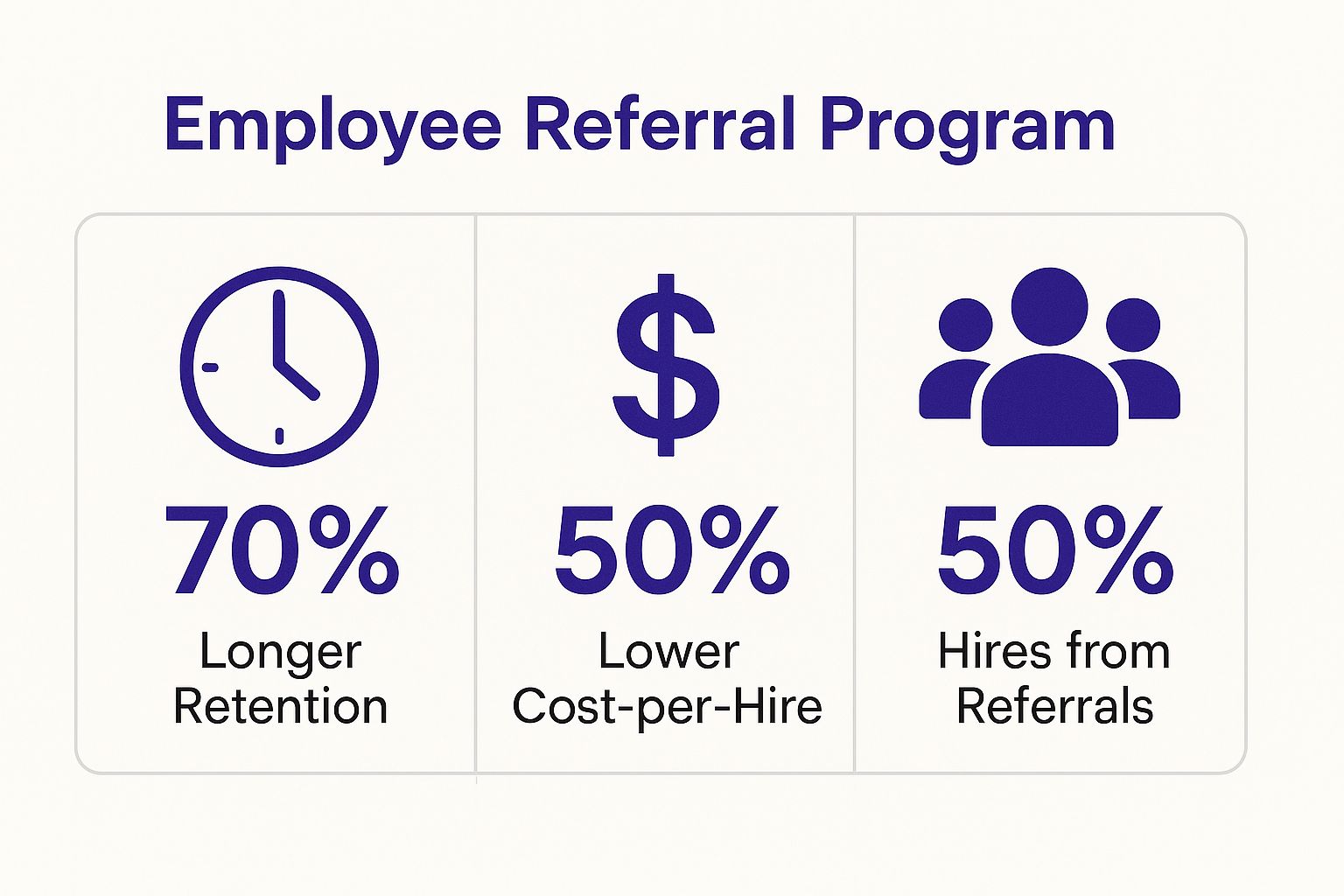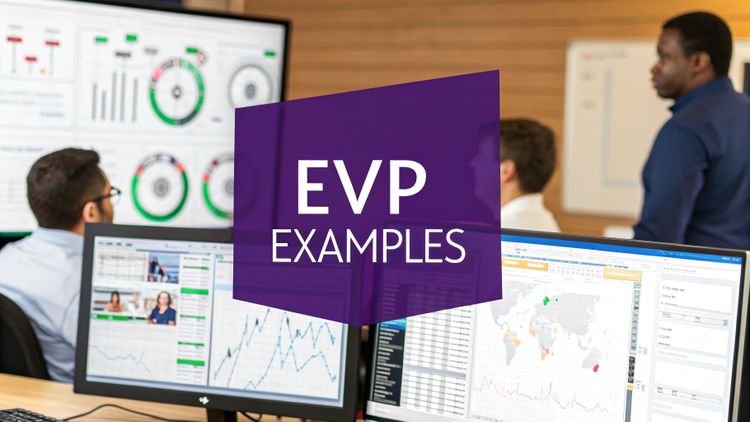Industry Trends
Top Talent Acquisition Strategies to Boost Your Hiring

Why Your Hiring Approach Needs a 2025 Update
In today's fiercely competitive job market, the 'post and pray' recruitment method is no longer viable. Top candidates are discerning, well-informed, and expect a seamless hiring experience. Relying on outdated practices results in prolonged vacancies, a high cost-per-hire, and ongoing challenges in attracting the skilled professionals your business needs to grow, particularly in critical UK sectors like healthcare and hospitality.
Listen to the Podcast Here:
The challenge extends beyond finding people; it's about attracting the right individuals who align with your company culture and will drive future success. This shift necessitates moving away from reactive recruiting towards a proactive approach. To compete for the best talent, small and medium-sized enterprises need a modern toolkit of effective talent acquisition strategies.
This article provides just that: a roundup of 10 modern, actionable strategies that deliver tangible results. We will go beyond theory to offer practical implementation steps for each one. From building a robust employee referral programme and creating an appealing employer brand to integrating AI for smarter screening and sourcing passive candidates, you will receive a clear roadmap. Consider this your framework for constructing a strong, efficient, and data-driven hiring engine for 2025 and beyond.
1. Employee Referral Programmes
An employee referral programme is one of the most effective talent acquisition strategies for sourcing high-quality candidates. This systematic approach encourages current employees to recommend qualified individuals from their professional networks. As your team understands your company culture and the requirements of specific roles, their recommendations often result in better fits, leading to quicker hiring cycles and enhanced team cohesion. This strategy transforms your entire workforce into a powerful recruiting engine.
The impact of a well-organised referral programme on key business metrics is significant, as illustrated in the data below.

These figures show that referrals significantly reduce hiring costs and lead to employees who are more likely to stay, enhancing long-term retention.
How to Implement a Successful Referral Programme
To maximise results, structure your programme carefully. Companies like Accenture have achieved great success, with their referral programme boasting a 40% success rate. Key actions include:
Set Clear Criteria: Define the qualifications and experience required for open roles to guide your employees and ensure they submit relevant candidates.
Offer Tiered Rewards: Motivate employees by offering different bonus levels based on the role's difficulty. A larger incentive for a senior role that is hard to fill is more compelling.
Communicate Consistently: Keep the referring employee updated on their candidate's progress and promote the programme regularly through internal channels like email or team meetings.
For a comprehensive guide, discover how to build a successful employee referral programme from the ground up.
2. Employer Branding and Value Proposition
Developing a strong employer brand is one of the most proactive talent acquisition strategies an organisation can adopt. It involves managing and influencing your reputation as an employer among job seekers, employees, and stakeholders. A compelling brand communicates your unique Employer Value Proposition (EVP), which is the core promise of what employees receive in return for their commitment, ultimately attracting candidates who are a perfect fit for your culture and mission.

This strategy shifts recruiting from an outbound chase to an inbound magnet. For instance, Patagonia’s brand, built on environmental activism, naturally attracts purpose-driven individuals who are passionate about its mission. Similarly, Netflix’s famed 'Freedom and Responsibility' culture draws innovative thinkers who thrive on autonomy. This attraction reduces reliance on costly job boards and sourcing efforts, filling your pipeline with aligned, high-quality talent.
How to Build a Strong Employer Brand
To effectively build your brand, focus on authenticity and consistent communication. The goal is to reflect the genuine experience of working at your company. Key actions include:
Define Your EVP: Conduct employee surveys and workshops to uncover what your team truly values about your culture, benefits, and growth opportunities.
Showcase Employee Stories: Feature real employee testimonials, career journeys, and day-in-the-life content on your careers page, social media, and job descriptions.
Manage Your Online Presence: Actively engage on platforms like Glassdoor and LinkedIn. Respond to reviews thoughtfully and share content that reinforces your company values.
Align Brand Messaging: Ensure your employer brand is consistent with your consumer brand, creating a cohesive and trustworthy identity for both customers and potential hires.
For a complete blueprint, learn how to build a strong employer brand that attracts top talent and gives you a competitive edge.
3. Social Media Recruiting
Social media recruiting is one of today's most essential talent acquisition strategies, enabling you to connect with candidates on the platforms they use daily. This approach goes beyond merely posting job vacancies; it focuses on building an authentic employer brand, engaging with professional communities, and showcasing your unique company culture. By using platforms like LinkedIn, Twitter, and Instagram, you can attract both active job seekers and high-quality passive candidates who align with your values.

This method humanises your brand and builds relationships before an application is submitted. Companies see significant returns: Unilever, for example, generates 30% of its hires through its LinkedIn strategy, while Starbucks uses Instagram to visually share its vibrant workplace culture and attract talent that fits its brand.
How to Implement Successful Social Media Recruiting
To turn social platforms into a powerful recruiting channel, focus on strategic engagement. Key actions include:
Develop Platform-Specific Content: Tailor your message to each platform. Use LinkedIn for professional insights and job postings, Twitter for industry conversations (as IBM does for tech talent), and Instagram to visually showcase your company’s daily life.
Engage Authentically: Move beyond broadcasting job ads. Participate in relevant conversations, share valuable content, and respond to comments to build a genuine community. This builds trust and positions you as an employer of choice.
Leverage Employee Networks: Encourage your team to share job openings and company news on their personal profiles. This organic amplification expands your reach into trusted networks and adds credibility to your recruitment marketing.
To truly harness these platforms, discover how to integrate social media recruiting into your hiring strategy.
4. Diversity and Inclusion Hiring
Diversity and Inclusion (D&I) hiring is a critical component of modern talent acquisition strategies. It involves proactively building a workforce that reflects a wide range of backgrounds, perspectives, and experiences. This approach goes beyond simply meeting quotas; it focuses on creating an equitable recruitment process where every candidate is evaluated fairly. By embedding inclusivity into your hiring, you can access a broader talent pool, foster innovation, and better understand a diverse customer base.
The business case for D&I is compelling. Companies that prioritise it often see significant improvements in performance and employee engagement. For example, Johnson & Johnson's diverse slate approach helped increase minority hires by 25%, while Salesforce has achieved 50/50 gender representation globally. These successes highlight how a dedicated D&I strategy directly contributes to building stronger, more representative, and higher-performing teams.
How to Implement a Successful D&I Hiring Strategy
To effectively integrate D&I into your hiring, you need a structured and intentional approach. Key actions include:
Mitigate Unconscious Bias: Implement blind CV screening to focus on skills over demographics and train hiring managers on inclusive interviewing techniques to ensure fair evaluations.
Expand Sourcing Channels: Partner with organisations focused on underrepresented groups to attract a more diverse applicant pool and move beyond traditional recruitment networks.
Set and Track Targets: Establish clear diversity goals for your hiring pipeline and leadership roles. Regularly measure progress to maintain accountability and drive meaningful change.
Use Inclusive Language: Review job descriptions to remove gender-coded words or jargon that might discourage qualified candidates from applying.
For a deeper dive, discover the best practices for diversity recruiting and start building a more equitable workplace.
5. Talent Pipelining and Relationship Building
Talent pipelining is a proactive approach that stands out among modern talent acquisition strategies. Instead of scrambling to fill a vacancy, you build and nurture a pool of qualified, pre-vetted candidates who are already familiar with your brand. This method shifts recruitment from a reactive, transactional process to a strategic, relationship-driven function. By engaging with potential future hires over time, you create a continuous flow of interested talent ready for when the right opportunity arises.
The strategic value of this approach is demonstrated by leading global firms. Consulting giants like McKinsey & Company build relationships with top MBA students years before they graduate, while Deloitte's powerful alumni network is so well-nurtured that it generates 25% of their experienced hires. This proactive engagement significantly reduces time-to-fill and ensures a consistent supply of high-calibre candidates who are already aligned with the company's ethos.
How to Build a Successful Talent Pipeline
To effectively implement this strategy, focus on consistent, long-term engagement. Key actions include:
Segment Your Talent Pools: Use a Candidate Relationship Management (CRM) system to organise candidates by skills, experience, and interests. This allows for highly targeted and relevant communication.
Create Valuable Touchpoints: Go beyond job alerts. Share relevant industry news, company updates, or insightful content to keep your brand top-of-mind and build genuine rapport with passive candidates.
Maintain Regular Communication: Establish a steady cadence for engagement, such as a quarterly newsletter or personalised check-ins, to nurture relationships without overwhelming potential candidates.
6. AI and Automated Screening
Integrating artificial intelligence into your hiring process is one of the most forward-thinking talent acquisition strategies for managing high applicant volumes. This approach uses machine learning algorithms to automate repetitive tasks like resume screening, candidate matching, and initial assessments. By using technology to handle the preliminary stages, your recruitment team can focus its expertise on engaging with the most promising candidates, dramatically increasing efficiency and reducing time-to-hire.
The impact of this strategy is significant for large-scale hiring. Unilever, for example, uses AI to screen 1.8 million applications annually, while Hilton’s AI chatbot successfully handles 85% of initial candidate questions. Similarly, L'Oréal has improved diversity by 15% through its algorithm-based screening, showing AI's potential to create a more equitable and effective recruitment funnel by mitigating unconscious bias.
How to Implement AI and Automated Screening Successfully
To use this technology effectively, a structured and ethical approach is essential. Pioneers like HireVue and Pymetrics have shown that AI can enhance, not replace, human judgment. Key actions for a successful rollout include:
Start with a Pilot Programme: Begin by testing AI tools on high-volume positions to measure their effectiveness and return on investment before a company-wide implementation.
Audit for Bias Regularly: Continuously review your algorithms to identify and correct any potential biases, ensuring your screening process remains fair and compliant.
Maintain Human Oversight: Always involve a human recruiter in the final decision-making stages to provide critical context and ensure the best cultural fit.
Communicate with Transparency: Be open with candidates about how and when AI is used in the process. This builds trust and improves the candidate experience.
To find the right solutions for your organisation, explore the top recruitment automation software tools to streamline your hiring.
7. Campus Recruiting and University Partnerships
Campus recruiting and university partnerships represent a forward-thinking talent acquisition strategy focused on building a sustainable pipeline of new talent. This approach involves establishing strong relationships with universities to attract and hire promising students and recent graduates. By engaging early through career fairs, internships, and on-campus events, companies can build brand awareness and gain access to a fresh pool of candidates equipped with the latest skills. This strategy is essential for shaping your future workforce from the ground up.
The long-term value of this strategy is proven by industry leaders. Tech giant Google, for example, sources a significant number of new hires through its university programmes, showcasing the channel's effectiveness. Likewise, traditional consulting firms like McKinsey and investment banks like Goldman Sachs have long relied on this approach. These partnerships secure a consistent flow of high-potential, early-career professionals who can be trained to align with the company's culture and future needs.
How to Implement a Successful Campus Recruiting Strategy
An effective programme requires a strategic and engaging approach, focusing on deep relationships over a wide, superficial net. Key actions to ensure success include:
Focus on Target Schools: Concentrate your efforts on 10-15 key universities that align with your talent needs. This builds deeper partnerships and a stronger brand presence than a scattered approach.
Offer Meaningful Projects: Structure internships around impactful projects, not just administrative tasks. This gives students real experience and provides you with a true assessment of their potential and skills.
Utilise Alumni Ambassadors: Involve recent graduates in your recruiting events. They act as powerful and relatable brand ambassadors, offering authentic insights to prospective candidates.
8. Contingent and Gig Economy Talent
Engaging freelancers, contractors, and gig workers is a highly flexible talent acquisition strategy for modern business needs. This approach allows organisations to access specialised skills on-demand, adapt quickly to market changes, and manage costs effectively. By tapping into the contingent workforce, you can fill critical skill gaps for specific projects without the long-term commitment of hiring a full-time employee, boosting operational agility.
The gig economy is no longer just for startups; it is a mainstream talent source. For instance, Upwork reports that 57% of Fortune 500 companies use its platform to source independent talent. This model is effective across diverse industries, from NASA using freelance engineers for specialised projects to Pfizer using contract researchers to accelerate drug development, showing its power to secure elite expertise.
How to Effectively Integrate Contingent Workers
To get the most from this talent pool, a structured approach is essential. Key actions include:
Develop Clear Onboarding Processes: Create a streamlined integration process specifically for contractors to ensure they align with your company’s goals and culture from day one.
Establish Clear Agreements: Protect your business and intellectual property by implementing robust confidentiality and work-for-hire agreements before any project begins.
Build a Talent Community: Maintain relationships with high-performing freelancers and contractors for future projects, creating a reliable and pre-vetted pool of on-demand talent.
Create Hybrid Teams: Blend full-time employees with contract talent on project teams to foster collaboration and knowledge sharing across your entire workforce.
For further guidance, explore best practices for managing a contingent workforce to ensure compliance and productivity.
9. Data-Driven Recruitment Analytics
Data-driven recruitment analytics involves the systematic use of data to optimise hiring processes and make evidence-based decisions. This approach moves beyond intuition, using metrics to refine every stage of the recruitment funnel. As one of the most transformative talent acquisition strategies, it enables HR teams to measure what works, predict future needs, and demonstrate the strategic value of their efforts. This turns recruitment into a measurable science, driving continuous improvement.
The impact of this strategy is profound. Google's renowned People Analytics team, for instance, improved the quality of its hiring decisions by 25% by analysing performance data against interview feedback. Similarly, Marriott International used analytics to reduce its time-to-hire by 30%, showing how data can directly boost efficiency and business performance across its properties.
How to Implement Data-Driven Recruitment Analytics
To effectively integrate data into your hiring, focus on creating a clear framework. Key actions include:
Start with Foundational Metrics: Begin by tracking essential data points like time-to-hire, cost-per-hire, and source-of-hire. These metrics provide a baseline for measuring success and identifying bottlenecks in your process.
Invest in Integrated Systems: Use an Applicant Tracking System (ATS) or Human Resources Information System (HRIS) to centralise data collection. A single source of truth prevents data silos and ensures accuracy for reporting.
Focus on Actionable Insights: Don’t just collect data—analyse it to answer strategic questions. Use A/B testing on job descriptions or outreach methods to see what performs best and connect recruitment metrics directly to business outcomes.
10. Passive Candidate Sourcing
Passive candidate sourcing is a proactive recruitment method focused on identifying and engaging high-calibre professionals who are not actively seeking new jobs. This is one of the most sophisticated talent acquisition strategies, as it involves deep research and relationship-building to access a talent pool that ignores traditional job adverts. By reaching out to employed, high-performing individuals, you can attract talent that your competitors are unable to find.
The power of this approach is evident in how top companies operate. Tech giants like Facebook have historically sourced a high percentage of engineers through passive channels, while Apple’s talent teams are known for building relationships over several years before a role even becomes available. This long-term strategy, central to executive search firms, ensures a pipeline of vetted, top-tier candidates is always ready.
How to Effectively Source Passive Candidates
A successful passive sourcing strategy requires patience, personalisation, and a focus on building genuine connections. Key actions include:
Utilise Advanced Sourcing Tools: Master platforms like LinkedIn Recruiter and employ Boolean search techniques, championed by experts like Glen Cathey, to pinpoint exact profiles based on skills, experience, and company history.
Craft a Compelling Outreach: Avoid generic templates. Your initial message must be highly personalised, referencing a candidate's specific work or accomplishments to demonstrate genuine interest and research. Frame the conversation around a potential career advancement, not just a job vacancy.
Build Relationships Gradually: Focus on creating a professional connection before pushing an immediate opportunity. Share valuable industry content, invite them to a webinar, or connect them with others in your network to build trust and credibility over time.
Talent Acquisition Strategies Comparison Matrix
| Strategy | Implementation Complexity 🔄 | Resource Requirements ⚡ | Expected Outcomes 📊 | Ideal Use Cases 💡 | Key Advantages ⭐ |
|---|---|---|---|---|---|
| Employee Referral Programmes | Moderate - requires ongoing programme management | Moderate - incentives & platform tools | High quality hires, faster placements, ↑ retention | Companies seeking cultural fit and quick hires | Lower cost-per-hire, better retention, faster fill |
| Employer Branding and Value Proposition | High - long-term strategic effort | High - multi-channel campaigns | Gradual brand strengthening, organic attraction | Organisations building employer reputation | Attracts top talent, reduces ad spend, competitive advantage |
| Social Media Recruiting | Moderate - platform management & content | Moderate - social media and ads budget | Broader reach, access to passive candidates | Reaching diverse & tech-savvy candidates | Cost-effective, real-time engagement, targeted ads |
| Diversity and Inclusion Hiring | High - process overhaul & training | High - partnerships, training | More innovative, diverse workforce, improved brand | Companies prioritising inclusive hiring | Access to diverse talent, better innovation, legal compliance |
| Talent Pipelining and Relationship Building | High - continuous CRM and networking | High - CRM systems, communication | Reduced time-to-hire, quality pipeline maintenance | Organisations with future hiring forecast | Access to passive talent, cost-effective long-term |
| AI and Automated Screening | High - technical setup and auditing | High - AI tools & maintenance | Faster screening, data-driven candidate evaluation | High-volume recruitment needing efficiency | 24/7 processing, objective evaluation, large volume |
| Campus Recruiting and University Partnerships | Moderate - programme & event coordination | Moderate - university relations | Access to fresh talent, brand building on campuses | Entry-level & early career hiring | Access to latest skills, leadership pipeline |
| Contingent and Gig Economy Talent | Moderate - vendor & compliance management | Moderate - platforms and contract management | Flexible workforce scaling, faster project execution | Projects requiring specialised, on-demand skills | Agility, cost efficiency, global access |
| Data-Driven Recruitment Analytics | High - data infrastructure & analysis | High - analytics tools & expertise | Optimised recruitment processes, better ROI | Data-focused organisations optimising hiring | Evidence-based decisions, process improvements |
| Passive Candidate Sourcing | High - research and relationship building | High - sourcing tools & skilled staff | Access to top talent not actively job searching | Recruiting senior/ specialised roles | Higher quality hires, competitive advantage |
Unifying Your Strategies for Maximum Impact
Throughout this article, we have explored ten distinct and powerful talent acquisition strategies, from using employee referrals to employing data analytics. While implementing any one of these can yield positive results, their true power is only realised when they are woven together into a single, cohesive framework. A fragmented approach, where social media efforts are disconnected from employer branding and data is isolated, leads to inefficiencies and missed opportunities.
The most successful organisations view talent acquisition not as a series of isolated tasks, but as an interconnected ecosystem. Your success depends on creating synergy between these different pillars.
From Individual Tactics to an Integrated Ecosystem
Think of how these strategies feed into one another. A compelling Employer Value Proposition (EVP) and strong employer brand fuel your social media recruiting and passive candidate sourcing efforts. Without a clear message, your outreach will fall flat. Similarly, building a proactive talent pipeline becomes far easier when your brand consistently attracts the right people.
This interconnectedness is where modern recruitment truly shines. Consider these relationships:
Branding and Sourcing: Your EVP is not just a statement; it's the core message that makes your passive sourcing emails and social media posts compelling and effective.
Technology and Relationships: Using AI and automated screening frees up your recruiters’ valuable time, allowing them to move from administrative tasks to building genuine relationships with candidates in your talent pipeline.
Diversity and Reach: A clear commitment to Diversity and Inclusion hiring is amplified through targeted campus recruiting partnerships and inclusive social media campaigns, significantly widening your talent pool.
Your Actionable Next Steps
Moving from a disjointed process to a unified strategy requires deliberate action. Here is a practical roadmap to get you started:
Conduct a Strategic Audit: Begin by benchmarking your current hiring process against the ten strategies discussed. Where are your strengths? More importantly, where are the most significant gaps or opportunities for improvement?
Prioritise for Immediate Impact: You do not need to overhaul everything at once. Based on your audit, select two or three strategies that will deliver the most value for your organisation right now. For a hospitality business, this might be optimising social media recruiting for local talent and launching a dynamic referral programme.
Integrate and Measure: The critical step is to connect your chosen initiatives. Plan how they will work together and, crucially, how you will measure their collective success. Implement data-driven recruitment analytics from day one to track key metrics like source of hire, time to fill, and quality of hire for each channel. This data is essential for refining your talent acquisition strategies and demonstrating their ROI.
The True Value of a Modern Talent Acquisition Framework
Mastering and integrating these approaches elevates the role of recruitment from a support function to a core business driver. A cohesive strategy enables you to attract talent that not only possesses the right skills but also aligns with your company culture, significantly reducing costly turnover and boosting team morale. This is how you build the resilient, innovative, and dedicated workforce needed to thrive in today’s competitive landscape.
Ultimately, a deliberate and integrated approach to hiring is a direct investment in your organisation’s future. You are not just filling vacancies; you are consciously building the team that will propel your business forward.
Executing a unified strategy is nearly impossible with disconnected tools. An all-in-one platform like SeeMeHired provides the central hub needed to manage these moving parts, from multi-channel job posting and AI-powered screening to real-time analytics. Empower your team to make smarter hiring decisions by bringing your entire talent acquisition process under one roof.





























